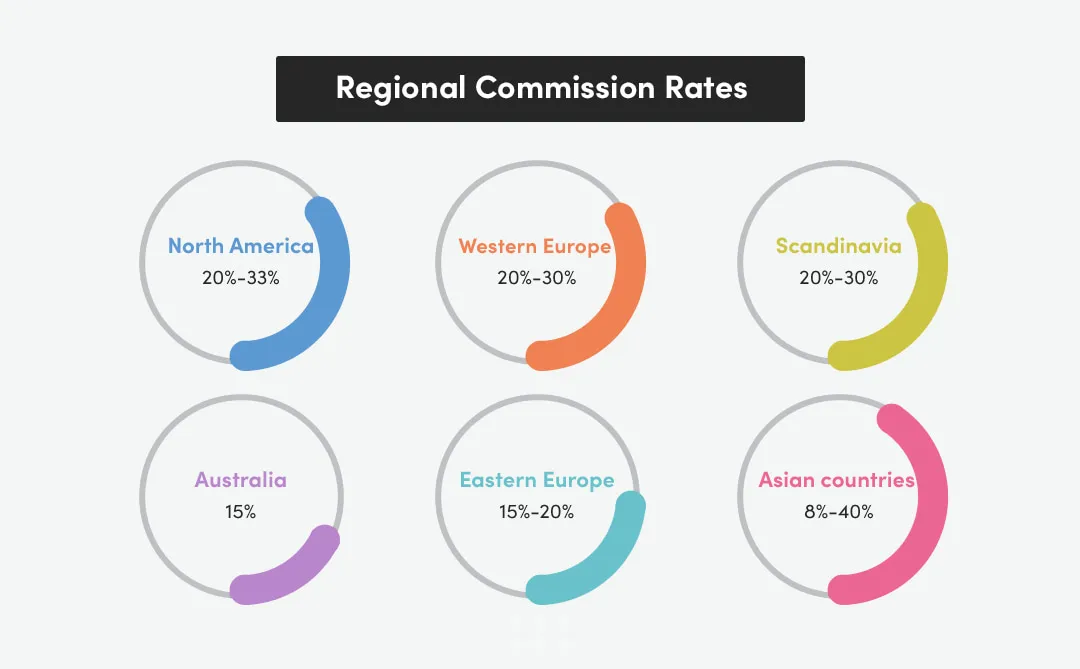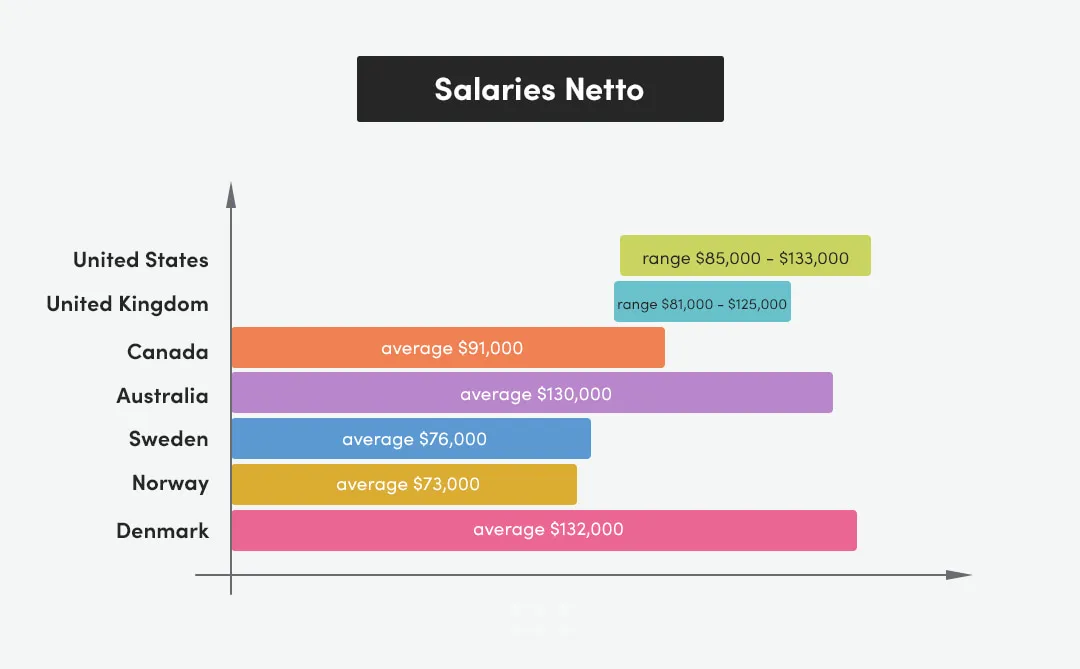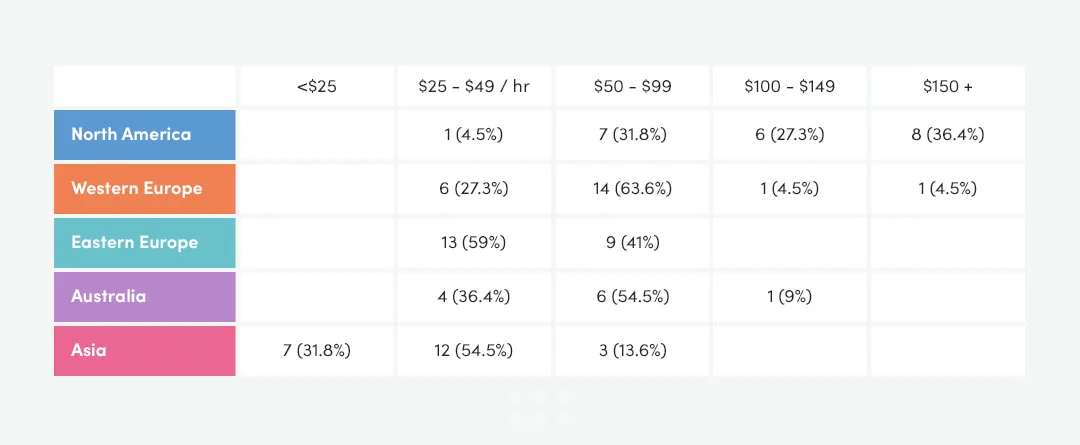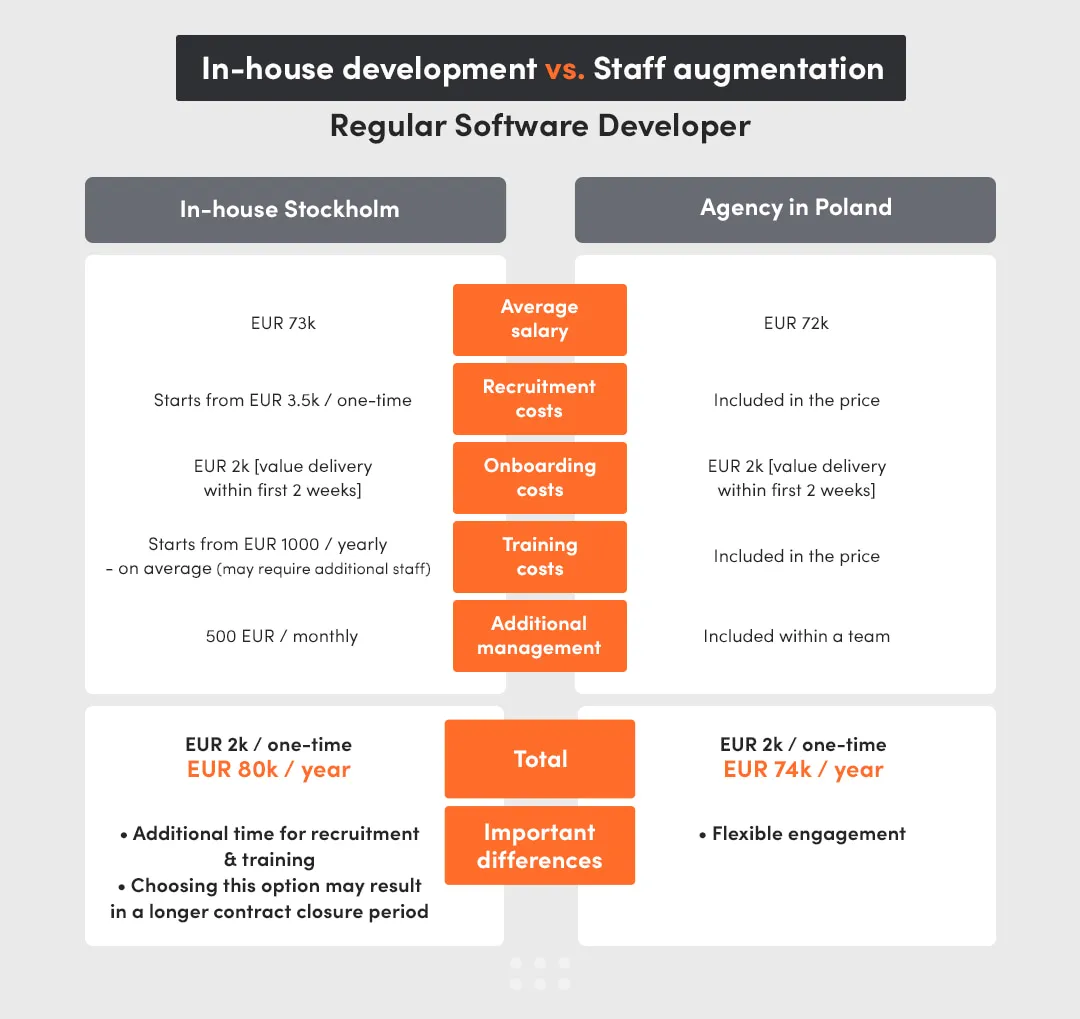Software development is becoming indispensable for businesses across all sectors. Making the right choices for all development initiatives is crucial for achieving success while staying within the budget. First and foremost, businesses must decide how they want to build their software team.
You have two main choices for doing so:
- In-house development.
- Staff augmentation.
So, here’s what you’ll learn from this article:
- Why should I consider the costs when choosing in-house hiring vs. staff augmentation?
- What cost factors should I consider for calculating the cost of in-house hiring?
- What cost factors should I consider for calculating the cost of staff augmentation?
- How do the cost flexibility and scalability of the two solutions compare?
- What factors should I consider when choosing between in-house development and staff augmentation?
- How to calculate the true cost of in-house hiring and staff augmentation?
- Which of the two is the right choice for me?
Key Highlights of Hiring an IT Specialist:
In-house Hiring
- Costs start from around 3500$ (recruitment and onboarding)
- Annual salaries range from $10k to $130k based on location
- Average training costs $1,252 per employee
- Management requires extra 10% of team time
- Internal experience is essential
- Longer preparation time to deliver value
Staff Augmentation
- Annual salaries range from $25k to $200k based on location
- Recruitment, training, and management are outsourced
- Access to a diverse talent pool from various projects
- Ensures quick value delivery
Both have their merits and trade-offs. In order to pick the right one and manage your resources effectively, it is absolutely crucial to calculate the true cost of each.
Having said that, cost calculations can get a bit tricky as both options have some hidden overhead costs and factors that can easily slip under the radar. And neglecting to get the true cost can lead to all sorts of headaches — think budget overruns, resource over/underutilization, compromised quality, and pesky delays in project completion. To avoid the hassle, you need to evaluate the costs right, and that is exactly what you’ll learn in this article.
What Are the Cost Factors of In-house Hiring?
In-house hiring typically involves recruiting full-time software developers to work within your office premises as a part of your internal development team. Organizations choose in-house hiring for better communication, discretion, and control over projects, processes, and organizational culture. However, in-house hiring is a resource-intensive undertaking, not just in terms of direct costs but also in terms of the time and commitment required to recruit, onboard, and nurture a skilled and cohesive team.
Calculating the costs of in-house hiring can be complicated due to various indirect and hidden cost factors. In addition to direct costs associated with salaries and benefits, recruitment, onboarding, and training, you must also consider factors like administrative overhead, infrastructure costs, ongoing skill development, and employee turnover. When you take all these factors into account collectively and over the long term, the cost of in-house development can easily surpass your initial cost estimates.
Hiring and Recruitment
Hiring and recruitment expenses include all the costs associated with finding, bringing in, and integrating new talent. It includes factors like advertising the job, interviewing candidates, running background checks, and assessing their skills.
Internal recruiting can cost a company around $*3500 **per hire, on average.*
Sometimes, companies also use recruitment agencies or job portals, which can add extra costs. Also, consider and calculate the onboarding expenses, like training and providing the tools and equipment needed. All of this takes time and effort from HR, managers, and other team members, which means more costs.

Hiring costs vary notably across job positions and regions. For instance, recruitment agencies in North America typically charge 20%-33% of the employee's initial salary. This range is around 20%-30% in Western Europe, 20%-30% in Scandinavia, 15%-20% in Eastern Europe, around 15% in Australia, and 8%-40% across different Asian countries. The actual cost difference will depend not only on these regional commission rates but also on the wide variation in average base salaries across these regions.
Salaries
Keeping the skill level and experience constant, salaries and benefits can still vary depending on the geographical location. The cost of living and the prevailing salary standards in a particular region influence the salary expectations of potential employees. For example, the average salary of a software developer in the United States ranges from $85,000 to $133,000, before considering taxes and withholdings. In contrast, software developers in the United Kingdom typically receive a net salary ranging between $81,000 and $125,000 on average. Average salaries also vary substantially in other regions. In Canada, the average salary is $91,000, while in Australia, it amounts to $130,000.
Moving to Scandinavia, the average salaries differ — approximately $76,000 in Sweden, $73,000 in Norway, and $132,000 in Denmark. Additionally, it's important to note that tax costs in these regions are significantly high and must be calculated beforehand. Across Asia, average salaries are comparatively lower. In India, the average stands at $10,000, in China at $49,000, and in the Philippines at $17,000, all figures excluding taxes.

Benefits
In addition to the base salaries mentioned above, you would have to offer various benefits and perks to attract and retain employees. These can include health insurance, retirement plans, stock options, flexible work arrangements, meal and sports vouchers, paid time off, bonuses, and more. The additional benefits and their costs can also vary by region.
These benefits can cost you anywhere from 7.66% to 27% of an employee’s base salary in North America and 15.85% in Australia. The cost of employee benefits in Western Europe is four times higher than in Eastern Europe. Some Scandinavian countries happen to have lower cost of benefits, for instance, benefits make up 9.5% of an employee's base salary in Switzerland. However, let’s not forget that the base salaries in Scandinavian countries are quite high, to begin with. Conversely, benefits across Asia can be 16.75% (India) to 40.92% (China) of a base salary, but the base salaries can be exceptionally low in these countries.
Infrastructure
Setting up and maintaining the necessary infrastructure for software development also contributes to the overall cost of in-house hiring. This includes purchasing or licensing development tools, software, hardware, servers, and other equipment required for the development process. Keep in mind that infrastructure provisioning comes with the added administrative burden of managing and maintaining the infrastructure as well.
Ongoing Training and Skill Development
Continuously updating the skills of your development team is important for keeping pace with evolving technologies. You will need to invest in ongoing training, skill development, and certification programs. It incurs additional costs but ensures a highly competent and up-to-date workforce.

The upfront cost of certifications, such as AWS Certified Developer - Associate ($150), Microsoft Certified Azure Developer ($80-$165), or Google Professional Developer ($200 + applicable taxes) is just one aspect of training expenses. Other factors include preparatory courses, workshops, and materials that your employees will need to prepare for these certification exams. These direct and indirect training costs vary per region, depending on the regional certification and preparatory costs as well as taxation. All factored in, the costs of any certifications on the house can multiply several folds. On average, organizations spend $1,252 per employee on training and development initiatives.
Try our developers.
Free for 2 weeks.
No risk. Just results. Get a feel for our process, speed, and quality — work with our developers for a trial sprint and see why global companies choose Selleo.
What Are the Cost Factors of Staff Augmentation?
Staff augmentation involves hiring external professionals, or even a team, to work alongside your internal development team for a specific project or duration. Companies opt for staff augmentation to complement or extend their existing team with specialized skills without making long-term commitments. It allows them access to a larger talent pool and the ability to quickly scale up or down as needed.
Staff augmentation allows you to pay only for the number of hours worked and eliminates factors like benefits, insurance, or other overhead costs associated with traditional in-house hiring.
Having said that, there are a number of indirect cost factors associated with staff augmentation, too, that you must be aware of in order to get an accurate estimate of the overall staff augmentation costs.
Hourly Rates
The primary cost factor in staff augmentation is the hourly rate charged by the external developer. In addition to skill level and expertise, this rate can vary drastically based on the developers’ geographical location. To give you an idea, we’ve calculated the average hourly rates of software development houses (SDH) across different regions, based on the pricing listed on Clutch.co
For the sake of this article, we considered the top 22 non-sponsored companies from each region with over 50 employees and 10 customer reviews. Here is a comparison of the prevailing hourly rate ranges in different regions.

According to our findings, below are the probable hourly price ranges you’ll find in different regions:
- North America: $150+
- Western Europe: $50 - $99
- Australia: $50 - $99
- Eastern Europe: $25 - $49
- Scandinavia: $50 - $99
- South Asia: $25 - $49
South Asian regions provide significantly lower development costs compared to Western regions. However, be aware of potential language and cultural barriers as you move further from your home region. You can still benefit from the cost-effectiveness of offshore staff augmentation. To ensure smooth communication and collaboration, consider augmenting your staff from regions with similar language and norms. For example, collaborating with an Eastern European SDH which offers notably lower hourly rates than North America, Western Europe, and Scandinavia, is a viable option.
Management Costs
Staff augmentation initiatives also include expenses associated with overseeing and managing external developers. These costs cover the administrative and operational overhead required to facilitate and manage collaboration between the internal teams and the augmented staff.
It may vary depending on hiring individuals or independent product teams. In the case of individuals, customers usually must invest their time in the management of the team. In the case of an independent product team - it usually has a built-in leader among the team. Keep in mind that the management time required for a team of 5 individuals is at least 10% of their time.
Infrastructure and Tools
Integrating external team members into the company’s infrastructure may incur additional costs associated with technical adjustments and configurations, such as setting up email accounts, providing VPN access, or configuring access to shared resources and repositories. You will need to acquire additional licenses for accessing proprietary software, development and testing tools, and other resources your in-house team uses for development and collaboration.
Picking an external partner might reduce this cost significantly, thanks to their experience and/or partially covered infrastructure that is part of the partner workflow.
Travel and Accommodation
Travel and accommodation expenses may be involved if your external team member is in a remote region and needs to work on-site for certain project phases.
Hourly rates typically exclude some indirect costs that you may have to work out and re-negotiate if the project’s scope or requirements evolve. It’s always better to go for the more comprehensive “Time and Material Cost Model” for staff augmentation.
Time and Material Cost Model

The Time and Material Cost Model is a holistic pricing and project management framework that considers various cost factors beyond just hourly rates. The cost calculations are based on the number of developers devoted to your project and their hourly payments set by the SDH. It also considers other costs associated with the project, such as materials, tools, infrastructure, and additional expenses.
This model offers flexibility in adjusting project scope, resources, and materials as the project progresses. It aligns well with agile methodologies, allowing for iterative development and responsiveness to changes. It supports ongoing communication and adjustments throughout the project's lifecycle. Under this model, the SDH will follow neutral coding, ensuring that the code is always accessible, comprehensible, and transferable to other SDHs, should you need to switch or get multiple teams on board. This agility is invaluable given the ever-evolving technology landscape.
Evaluating Cost Flexibility and Scalability for In-house Hiring and Staff Augmentation
Businesses need to strike the right balance between talent acquisition and cost efficiency. Choosing the optimal approach for acquiring specialized skills requires careful and comprehensive analysis and comparison of each strategy in terms of its cost, viability, and flexibility. Below, we draw a comparison between the financial differences and benefits of both strategies to help you make an informed decision for your unique requirements.
Financial Differences
In-house hiring involves significant upfront costs, including recruitment expenses, onboarding, and provision of infrastructure and tools. In addition, ongoing expenses include benefits, training, and overhead costs on top of a basic salary. Other indirect or hidden costs may include work delays during the time it takes to hire and onboard the right talent. Enterprises typically allocate a budget for recruitment and can afford the additional expenditure for acquiring and retaining dedicated, specialized expertise in the long term. However, these costs can easily overwhelm small and medium-sized businesses (SMBs) with limited budgets.
Staff augmentation generally incurs lower upfront costs as you only have to pay for the hours worked, instead of consistent monthly salaries. Or, if your SDH offers it, you can adopt the time and material cost model, paying only for the resources consumed and work accomplished. Since staff augmentation allows companies to tap into highly specialized talent, companies can skip the extensive training and onboarding practices associated with in-house hiring and get new developers to integrate and start working immediately. With significantly fewer indirect and hidden costs, staff augmentation leads to better cost predictability, allowing you to meticulously manage your finances.
It is an interesting option if you want to speed up value delivery quickly rather than build all the processes for yourself.
Scalability
Another factor to consider is that in-house hiring implies a long-term commitment, making it least adaptable to fluctuating project demands. Long-term financial commitment to job roles that SMBs may not need in the long run, or those that do not fit with their core business, can drain finances and take resources away from business-critical tasks and engagements. Staff augmentation allows you to engage in short-term contracts, so you only pay for external developers when needed. This flexible scalability allows companies, especially SMBs, to optimize their spending and resource utilization and concentrate entirely on core business functions.
Impact of Cultural Differences on Cost and Communication

Cultural differences play a pivotal role in influencing a company’s hiring decisions. From a financial perspective, varying costs of living, attitudes toward work-life balance, negotiation practices, and perceptions of competitive compensation can lead to different salary expectations in different regions. However, in-house hiring from different regions presents challenges due to legal and immigration complexities, diverse labor laws, compliance issues, and logistical considerations.
Staff augmentation offloads these administrative and legal burdens to the staff augmentation provider, ensuring a smooth hiring process and faster onboarding. It allows companies to leverage these cultural differences and remotely acquire talent from countries with lower costs.
Now setting aside the financial perspective, cultural differences can sometimes affect team cohesiveness and may hinder seamless collaboration. This is a major concern for employers considering staff augmentation. By strategically hiring from less expensive but nearby countries and regions, you can potentially minimize the cultural differences that may arise from working with geographically distant employees. Through staff augmentation from regions in close proximity, you can strike the right balance between cost savings and cultural alignment for smoother communication and collaboration. For instance, instead of hiring from Western European and Scandinavian countries, you can augment your team with talent from Eastern European countries and leverage cost effectiveness without significant language and cultural barriers.
Case Study - Comparison of In-house vs. Staff Augmentation
In the following case study, we present numbers based on our existing customer for regular software engineering services compared to hiring a developer internally in Stockholm.

Source (updated - August 23, 2023)
Conclusion
Picking the right strategy for building your software development team — in-house or staff augmentation — depends on a careful and thorough evaluation of the true costs involved. With any approach, the total cost is not just about direct expenses, but also those hidden factors that determine if your project meets your budgeting constraints and reaches the finishing line to eventually become profitable.
Also, take a close look at your business needs and goals to make decisions that fit your unique situation. If you want long-term commitment and control over your projects, in-house hiring might be a good fit. It lets you build a tight-knit team within your company, which can be crucial for big, complex, and long-running projects that are core to your business. But, if you need to be flexible, deal with tight budgets, and want to access specialized skills without long-term ties, staff augmentation is the way to go. You can quickly ramp up or down your team and keep your focus on what really matters.
Another great approach that we often use is the mix of both worlds. Some customers have in-house team and staff augmentation as their default modus operandi - so that they can take what is the best from both solutions.
Ultimately, the choice between in-house and staff augmentation is all about balancing costs and getting the right talent for your business. So, assess your situation, weigh the options, and meticulously calculate the costs involved to steer your software development journey toward success, growth, and innovation.





